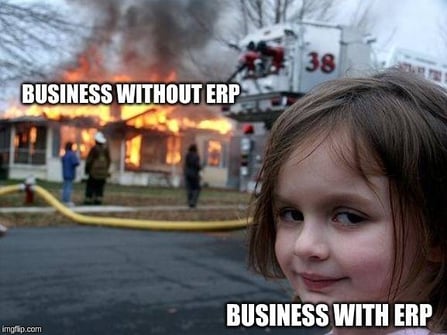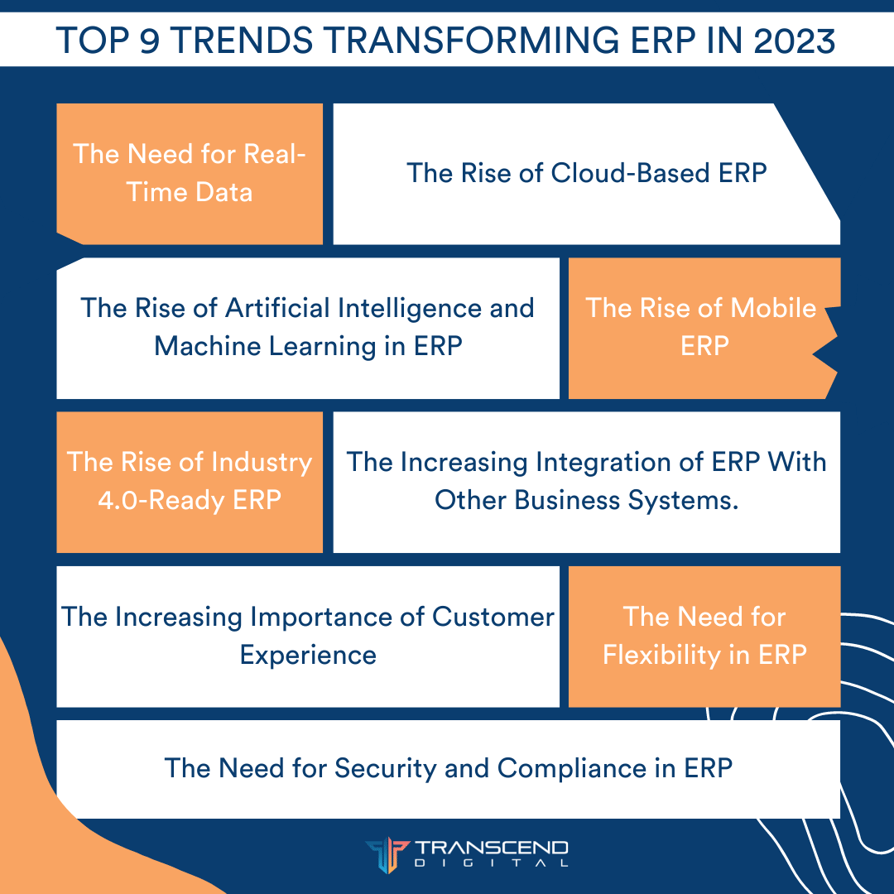Contents
- 1. What Is ERP and Why Is It Evolving?
- 2. Why Are Businesses Choosing Cloud-Based ERP Over Traditional ERP?
- 3. What Are the Challenges Associated With Implementing Cloud-Based ERP?
- 4. What Does the Future Hold for ERP?
- 5. What Implications Do These Trends Have for It Leaders and Organizations?
- 6. The Challenges of Implementing or Upgrading an ERP System
- 7. How To Get Ahead of the Curve With Your ERP System
Contents
- 1. What Is ERP and Why Is It Evolving?
- 2. Why Are Businesses Choosing Cloud-Based ERP Over Traditional ERP?
- 3. What Are the Challenges Associated With Implementing Cloud-Based ERP?
- 4. What Does the Future Hold for ERP?
- 5. What Implications Do These Trends Have for It Leaders and Organizations?
- 6. The Challenges of Implementing or Upgrading an ERP System
- 7. How To Get Ahead of the Curve With Your ERP System
Enterprise resource planning (ERP) solutions continue to evolve and incorporate new technologies that expand their support to most business functions.
ERP systems integrate almost all organizational processes, from back-end processes like HR and accounting to front-office functions like sales and customer service. ERP technologies improve efficiency, profitability, productivity, and competitiveness.
In this blog post, we'll explore the latest trends in ERP and what they mean for IT leaders. We'll also look at some of the challenges that organizations face when implementing or upgrading their ERP systems. So read on to learn more about the future of ERP and how you can get ahead of the curve!
What Is ERP and Why Is It Evolving?
ERP stands for enterprise resource planning. It's a business process management software that helps organizations streamline their operations and manage their resources more effectively. ERP systems are used to track and manage inventory, financial data, customer data, and other business information.
However, the traditional model of ERP is no longer adequate for the needs of modern businesses. The reason for this is that the business landscape has changed dramatically in recent years. Thanks to advances in technology, businesses are now more global and interconnected than ever before. They're also dealing with more data than ever before. As a result, they need an ERP system that is more flexible and adaptable to change.
1. The Need for Real-Time Data
One of the biggest challenges that businesses face today is the need for real-time data. In the past, businesses could get by with data that was updated on a daily or weekly basis. However, in today's fast-paced business world, that simply isn't enough. Customers expect businesses to have up-to-date information about their orders, and businesses need to be able to respond quickly to changes in the market. This need for real-time data has led to the development of cloud-based ERP systems.
2. The Rise of Cloud-Based ERP
Cloud-based ERP is a type of ERP that is hosted in the cloud, which is a network of servers that are located around the world. When you use a cloud-based ERP system, your data and applications are stored on these servers. These systems are designed to provide users with access to the most up-to-date information, regardless of where they are. This is a major advantage for businesses that need to be able to respond quickly to changes in the market.
Why Are Businesses Choosing Cloud-Based ERP Over Traditional ERP?
There are many advantages of cloud-based ERP, which is why it is becoming so popular. Some of the most notable benefits include:
- Cloud-based ERP systems are more scalable than traditional on-premises ERP systems. This means that they can grow and shrink as needed to meet the changing needs of businesses.
- Cloud-based ERP systems are more accessible than traditional on-premises ERP systems. This is because they can be accessed from anywhere with an internet connection.
- Cloud-based ERP systems are more affordable than traditional on-premises ERP systems. This is because businesses only have to pay for the resources they use, instead of making a large upfront investment in hardware and software.
- Cloud-based ERP systems offer improved security and disaster recovery capabilities. This is because the data is stored off-site in a secure data center.
- Lastly, cloud-based ERP systems are easier to implement and upgrade than traditional on-premises ERP systems. This is because there is no need to install or maintain any hardware or software.

What Are the Challenges Associated With Implementing Cloud-Based ERP?
There are some challenges associated with implementing cloud-based ERP, but they can be overcome with careful planning and execution. Some of the most common challenges include:
- Ensuring data security: One of the main concerns businesses have with cloud-based ERP is data security. However, there are steps that businesses can take to ensure that their data is safe and secure.
- Ensuring uptime: Another concern with cloud-based ERP is uptime. Businesses need to ensure that their systems are up and running at all times. To do this, they need to have a robust disaster recovery plan in place.
- Integrating with existing systems: One of the challenges of cloud-based ERP is integrating it with existing systems. Organizations need to carefully plan their integration strategy to avoid any disruptions to their operations.
Further Reading:
3. The Rise of Mobile ERP
ERP is evolving to keep up with the needs of modern businesses. One of the biggest trends in ERP is the rise of mobile-friendly systems. These systems are designed to be used on mobile devices, such as smartphones and tablets. This allows employees to access their ERP data from anywhere, at any time. This can be especially useful for employees who are constantly on the go or working remotely.
4. The Rise of Industry 4.0-Ready ERP
Industry 4.0 is the fourth industrial revolution. It is characterized by the convergence of physical, digital, and biological technologies. This convergence is transforming the way businesses operate and compete. In order to stay competitive, businesses need to implement Industry 4.0-ready ERP systems.
What Is Industry 4.0-Ready ERP?
Industry 4.0-ready ERP is an ERP system that is built to be used in an Industry 4.0 environment. These systems are designed to be highly flexible and adaptable. They are also designed to be integrated with other Industry 4.0 technologies, such as the Internet of Things (IoT) and artificial intelligence (AI).
One of the biggest benefits of using Industry 4.0-ready ERP is that it can help businesses be more agile and responsive to change. These systems are designed to be highly flexible. As a result, they can quickly adapt to changes in the market. On the other hand, Industry 4.0-ready ERP systems can be very expensive. As a result, businesses need to do cost-benefit analysis to assess the impact vs effort needed to deploy Industry 4.0-ready ERP.
5. The Rise of Artificial Intelligence and Machine Learning in ERP
Artificial intelligence (AI) is a branch of computer science that deals with the design and development of intelligent computer systems. These systems are designed to mimic the abilities of human intelligence, such as reasoning, learning, and problem-solving.
Machine learning is a type of AI that involves the use of algorithms to learn from data. These algorithms are used to improve the performance of a system by increasing its ability to make predictions or decisions.
The 2023 Guide to ERP Software Selection for IT Leaders
Navigate the maze of ERP selection with our freshly updated guide for IT leaders.
How Are AI and Machine Learning Being Used in ERP?
AI and machine learning are being used in ERP to automate tasks, such as data entry, order processing, and invoicing. These technologies can also be used to improve the accuracy of forecasting and decision-making. In addition, AI and machine learning can be used to create virtual assistants, such as chatbots.
The Challenges of Using AI and Machine Learning in ERP
While there are many benefits of using AI and machine learning in ERP, there are also some challenges that need to be considered. One of the biggest challenges is the lack of workers who are skilled in AI and machine learning. As a result, businesses may have difficulty finding the talent they need to implement these technologies.
6. The Increasing Integration of ERP With Other Business Systems
Another trend that is transforming ERP is the increasing integration of ERP systems with other business systems. In the past, ERP systems were stand-alone applications. However, today, they are often integrated with CRM systems, eCommerce platforms, and other business applications. This integration is crucial for businesses that want to provide a seamless customer experience and make the most efficient use of their resources.
7. The Need for Flexibility in ERP
As businesses become more global and diverse, they are finding that they need more customizability and flexibility in their ERP systems. One way to provide this customizability and flexibility is to use a cloud-based ERP system. Cloud-based ERP systems are designed to be highly configurable. They can be easily customized to meet the specific needs of a business.
8. The Increasing Importance of Customer Experience
Another trend that is transforming ERP is the increasing importance of customer experience. In the past, ERP systems were designed to meet the needs of businesses. However, today, they are also being designed to meet the needs of customers. This shift is because customers are increasingly demanding a better experience. Modern organizations need to ensure that their ERP systems are designed to provide a great customer experience.
9. The Need for Security and Compliance in ERP
As businesses become more reliant on ERP systems, they are also becoming more concerned about security and compliance. This is due to the fact that ERP systems often contain sensitive data, such as customer information and financial data. As a result, businesses need to ensure that their ERP systems are secure and compliant with all relevant regulations.
What Does the Future Hold for ERP?
ERP technologies are constantly evolving and becoming more sophisticated. In the future, ERP systems will become more intelligent, more user-friendly, and more integrated. As a result, they will become an even more essential tool for businesses of all sizes.
With the continued development of Industry 4.0 technologies, such as the Internet of Things (IoT) and artificial intelligence (AI), ERP systems will become even more flexible and adaptable. In addition, these technologies will continue to automate tasks, such as data entry, order processing, and invoicing. This will free up employees to do other tasks that are more value-added. As a result, businesses will become more efficient and effective.
What Implications Do These Trends Have for It Leaders and Organizations?
These trends have a number of implications for IT leaders and organizations. Here, we list the top-5:
- First, IT leaders need to ensure that their organizations are prepared for the changes that ERP systems will undergo in the future.
- Second, they need to ensure that their organizations have the right tools and technologies in place to take advantage of these trends.
- Third, they need to ensure that their ERP systems are able to meet the demands of a more global and diverse customer base.
- Fourth, they need to ensure that their ERP systems are able to provide a great customer experience.
- Finally, they need to ensure that their ERP systems are secure and compliant with all relevant regulations.
The Challenges of Implementing or Upgrading an ERP System
Cost is always a primary concern when implementing or upgrading an ERP system. But the price tag doesn't tell the whole story. An ERP project can also require a significant investment of time and resources, including employee training. It's important to consider the total cost of ownership (TCO) when deciding whether to implement or upgrade an ERP system.
Another challenge is finding the right ERP system for your business. With so many options on the market, it can be difficult to know where to start. The best way to find the right system is to assess your business needs and then compare your findings with the features and functionality of various ERP systems.
Once you've selected an ERP system, the next challenge is implementing it. This can be a complex and time-consuming process, particularly for large organizations with multiple locations. To ensure a successful implementation, it's important to have a clear understanding of your business requirements and objectives. It's also essential to partner with an experienced and reputable implementation partner.
Finally, there's the challenge of ongoing maintenance and support. Once your ERP system is up and running, you'll need to ensure that it remains compliant with changing regulations and that it keeps pace with the latest technological advances. To do this, you'll need to have a comprehensive support and maintenance plan in place.
While the challenges of implementing or upgrading an ERP system may seem daunting, the benefits far outweigh the risks. With the right preparation, partnering, and execution, any business can overcome these challenges to reap the considerable rewards an ERP system can offer.
How To Get Ahead of the Curve With Your ERP System
The first step is to ensure that you have a clear understanding of your business requirements and objectives. Once you have this understanding, you can begin to assess the various ERP systems on the market. It's important to compare the features and functionality of each system to ensure that you find the right system for your business. In this guide, we outlined the key things you need to consider when selecting an ERP system. Download it for free here: 2023 Guide to Selecting an ERP Software (+ checklist).
Once you've selected an ERP system, the next step is to partner with an experienced and reputable implementation partner. This partner will help you to overcome the challenges of deploying or upgrading your ERP system.
Transcend Digital is an award-winning provider of ERP solutions. We have a proven track record of helping businesses to overcome the challenges of implementing or upgrading an ERP system. From system selection and implementation to support and maintenance. We can help you to overcome the challenges of implementing or upgrading an ERP system and to get ahead of the curve with your ERP system. Contact us today to learn more.








